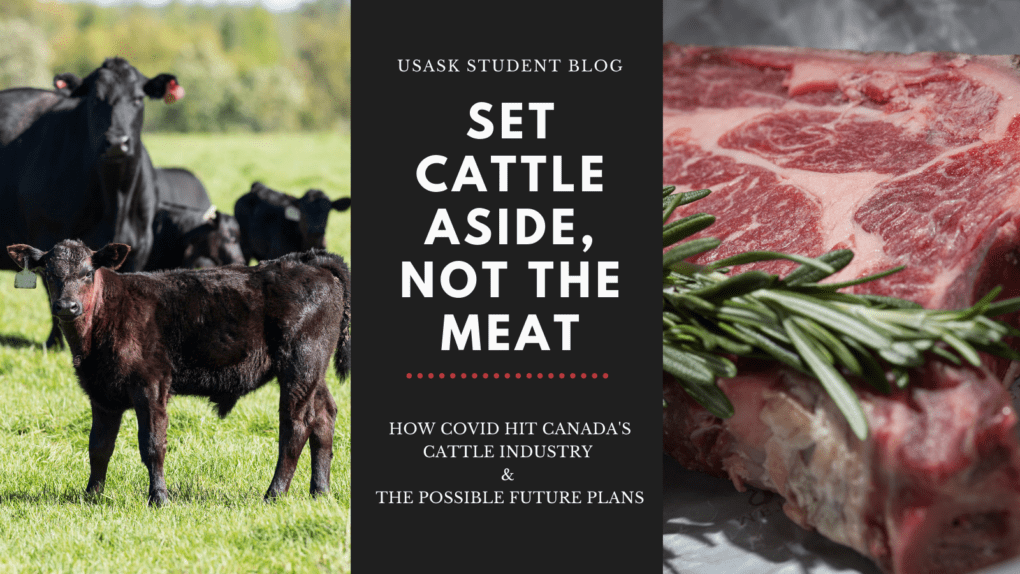By Oliver Xuan,
University of Saskatchewan Student
2020 has been a relatively more challenging year for every individual around the world. However, especially for Canada’s meat industry, maybe it is already winter in early May. Cargill plant and the JBS Canada plant in Alberta, which together normally process approximately 70% of Canada’s beef, has been temporarily shuttered or reduced operations in April because of the consideration of public health and prevention of spreading the pandemic (Sagan, 2020). Therefore, the meat plant’s normal capacity has been hard to maintain, the pace of processing has been slowed down, contributing to the backlog of large amounts of cattle in farms and decreased meat supply.
What is the Program about?
In this case, the Livestock Set-Aside Program was designed to ensure that the market-ready cattle matched up with the available processing capacity. According to the video (Canadian Cattlemen’s Association, 2020), this feed cost offset initiative pay producers per head of livestock held back for daily maintenance from the processing during the pandemic situation, and producers could submit the bids with the number of animals that meet the standard they are willing to set aside. The number of cattle that will be set aside each week would be assessed and determined by an industry advisory committee based on an assessment of the number of backlogged cattle waiting for processing. This program will continue unless all of the funds assigned ($42 million) have been distributed, or there is no need to set aside the cattle.
How does it go so far?
According to Glen (2020), the two major packing plants are restored to almost full capacity in June, with 130,000 heads of fed cattle left. After only two weeks of the program implementation, no cattle were accepted because the demand from packers of animals was strong again. (Cattle set-aside program off to a slow start, 2020). Therefore, it is evident that the policy already seemed ineffective, and it was only half a month after. What happened to the plan, though?
There is not only one sector in the meat supply chain
The program was designed to compensate the farm sector with cattle that have already been fed and ready for the slaughter process. However, it is evident and noticeable that there must not be only one sector affected in the whole supply chain. According to Glen (2020), numerous representatives like Kelly Smith-Fraser, chair of Alberta Beef Producers and Dennis Laycraft, executive vice-president of the Canadian Cattlemen’s Association, all expressed the concern for other background sectors like cow-calf producers because COVID-19 could cause ripple effects down the whole supply chain as well.
Decision-makers must include all possible stakeholders into consideration but not just for one sector. (Overview of Various Types of Research, n.d.) Although the outcome was not bad at this point, the reason might not be the policy but the pandemic’s temporary controlled situation. It is commonly believed that there might be a second wave coming. Therefore, in this case, is compensating just the fed cattle sector enough to cover the whole supply chain’s loss? Is this sector the most vulnerable? That might be something to think about because what is needed at this point is for the whole supply chain to function again, not just compensating for the loss for one sector.
How long will we suffer? Are we truly prepared for this?
Another controversial point here is the timeline. Is the timeline set coincide with the correct prediction here? Because the pandemic is dynamic, the problem might be more complicated than we think. Forty-two million were distributed to the program, and after two weeks, the plan was “set-aside,” with the number of producers in need declined.
If there would be a relief in this short of time in one sector, the 42 million could be used in other sectors like feeding cattle sector or even into other industries like crop insurance. If the pandemic lasts for an extended period of time with a second wave or even a third wave, the fund might not be enough to help the market function. The time here is relatively unpredictable, emphasizing the importance of having multiple back-up plans in hand to ensure that producers would not panic about severe loss during the unusual situation.
There are hopes to all Western Producers and Canadians about the future.
According to Livestock Set Aside Program in Saskatchewan, ten million dollars was distributed for the same kind of program. (Livestock Set Aside Program, 2020) However, the same as Alberta’s situation, there was a demand in the first week and interests have been lighter since the second week. (Cattle set-aside program off to a slow start, 2020).
Also, in the year 2003, when BSE was spread over North America, the same program was released in Canada. According to (Klein & Roy, 2010), the assistance programs had a similar magnitude as estimated losses to the industry. However, there were still some segments that had lost balance. (Probably rising from the same issue mentioned above)
Therefore, if managed well, based on history, the program could equalize the loss and compensation from the whole industry’s perspective. Now what we could do is waiting and monitoring the program to make sure that we are truly prepared for future dynamic situations and get rid of the imbalance that happened in the past.
Canadian Cattlemen’s Association. (2020, Jun 30). Title: CCA Virtual Roundup 05.28.2020 – Part 3, Alberta Beef Producers. Available at: https://www.youtube.com/watch?v=NnwZrAcvWLM
Cattle set-aside program off to a slow start. (2020, July 22). RealAgriculture.
Glen, B. (2020, June 18). Packers regain pace after slowdown. The Western Producer.
Klein, K., & Roy, D. G. (2010). BSE in Canada: Were Economic Losses to the Beef Industry Covered by Government Compensation? Canadian Public Policy, 36:2, 227-240.
Livestock Set Aside Program. (2020). Retrieved from Saskatchewan Crop Insurance Corporation: https://www.scic.ca/livestock-set-aside-program/#:~:text=The%20Saskatchewan%20Livestock%20Set%20Aside,animals%20caused%20by%20COVID%2D19.
Overview of Various Types of Research. (n.d.). Retrieved from PolicyNL: https://www.policynl.ca/policydevelopment/pages/types-of-research.html
Sagan, A. (2020, April 23). 2 Alberta meat plants affected by COVID-19 make up 70% of Canada’s beef processing capabilities. Global News.

Oliver Xuan
Hi, my name is Oliver Xuan. I grew up in China’s city area and came to Canada in 2016 for my post-secondary studies in Agriculture. I am currently in my fourth year of an Agribusiness Degree at U of S. Although I do not have a farm background, I am very interested in the agriculture industry, which I have become very passionate about over my four years of studies. My plan is to continue my studies in a master’s program, gain further insights about agriculture, and hopefully make my own contributions to agriculture in the future.


